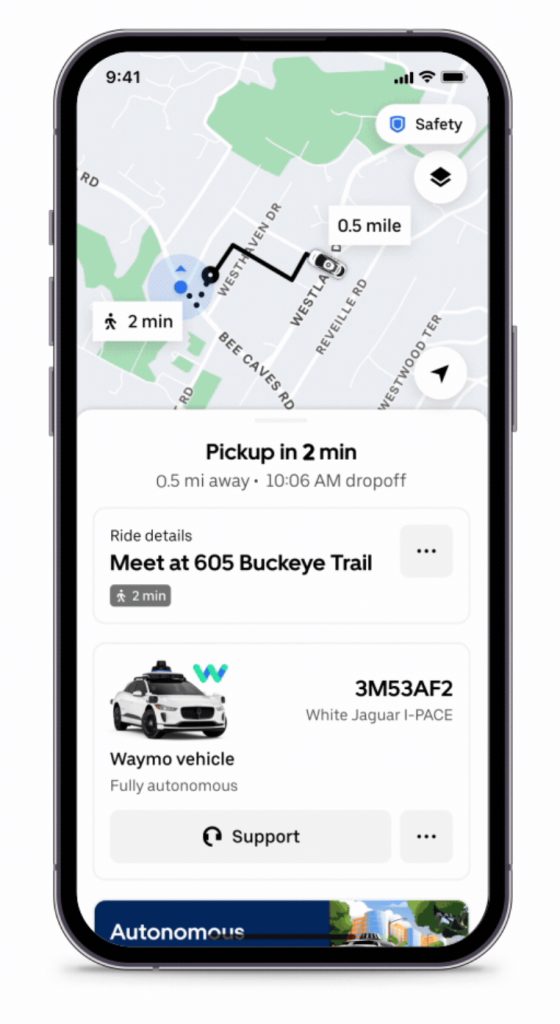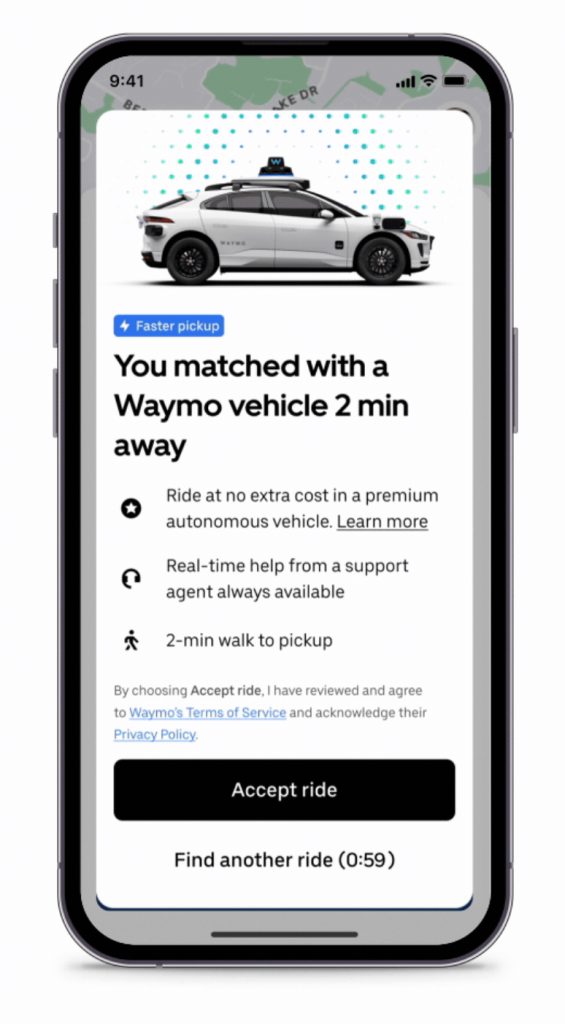News
Waymo, Uber launch driverless ride-hailing in Austin
The commercial robotaxi industry is heating up.

As the emerging commercial robotaxi space grows with Tesla and others set to start deploying self-driving ride-hailing services, Waymo, the robotaxi firm owned by Google parent company Alphabet, has officially launched driverless taxis in Texas, with the help of Uber.
As of Tuesday, those in Austin can officially take a driverless Waymo robotaxi using the Uber app, as detailed in a press release from the ride-hailing company. The launch comes as Tesla is expected to debut Unsupervised Full Self-Driving (FSD) services in Austin later this year, and after it was found to have applied for a permit to operate ride-hailing vehicles in California.
To access the Waymo robotaxis, users must opt in for the service on the Uber app at no additional cost. When awaiting rides, riders will have the option to accept the driverless Waymo robotaxi or to switch to a non-self-driving vehicle instead.
Additionally, riders will be able to use the Uber app to unlock the vehicle, open the trunk, and activate the trip, and the ride-hailing company also says it’s providing 24/7 customer support in case of any issues. The area of operation will allow riders to travel across 37 square miles of Austin, from Hyde Park to Downtown to Montopolis, and Uber also says the company plans to expand the service area in the future.
The launch also comes ahead of the South by Southwest (SXSW) music festival in Austin this weekend, which is expected to bring in bands and music enthusiasts from all over the world.
- Credit: Uber
- Credit: Uber
READ MORE ON ROBOTAXIS, TESLA’S FSD:
- Tesla is going in-house for robotaxi platform, says one competitor
- Tesla China owners share first impressions of FSD-style ‘City Autopilot’
- Tesla used this clever workaround to train FSD for China’s roads
- Tesla FSD’s rollout in Mexico is a bigger deal than it seems
- Cruise layoffs begin as GM winds down robotaxi business
- Waymo to test self-driving vehicles in another country in 2025
- Waymo study analyzes collisions with vulnerable road users
Waymo currently operates paid, self-driving ride-hails via an in-house platform through the Waymo One app in Los Angeles and around San Francisco, California, as well as in Phoenix, Arizona. As part of the announcement, Uber also says that the two companies will be partnering to launch robotaxi services in Atlanta, Georgia next.
During Tesla’s Q4 earnings call in January, CEO Elon Musk said that Tesla plans to launch its Unsupervised FSD system as a paid service in Austin in June. Tesla also operates a Gigafactory in Austin, where it builds the Model Y and the Cybertruck, and Musk has said launching in the city would let the company “dip its toe in the water” of commercial robotaxis with safety in mind.
In October, Musk also said that Tesla had been testing internal ride-hails for employees in the Bay Area, California, adding that users could already request a ride and be dropped off anywhere in the Bay. Last week, it was also widely reported that Tesla had in November applied for a “transportation charter-party carrier permit” from the California Public Utilities Commission (CPUC), which is the agency that helps regulate the state’s autonomous vehicles.
Tesla also launched its two-seat, steering wheel-less Cybercab in October during a Southern California event dubbed “We, Robot,” and you can see our coverage from the event below.
🎥: Our FULL first ride in the @Tesla Cybercab pic.twitter.com/6gR7OgKRCz — TESLARATI (@Teslarati) October 11, 2024
Tesla mobile app tracker reports first lines referencing robotaxi service

News
Tesla is not sparing any expense in ensuring the Cybercab is safe
Images shared by the longtime watcher showed 16 Cybercab prototypes parked near Giga Texas’ dedicated crash test facility.

The Tesla Cybercab could very well be the safest taxi on the road when it is released and deployed for public use. This was, at least, hinted at by the intensive safety tests that Tesla seems to be putting the autonomous two-seater through at its Giga Texas crash test facility.
Intensive crash tests
As per recent images from longtime Giga Texas watcher and drone operator Joe Tegtmeyer, Tesla seems to be very busy crash testing Cybercab units. Images shared by the longtime watcher showed 16 Cybercab prototypes parked near Giga Texas’ dedicated crash test facility just before the holidays.
Tegtmeyer’s aerial photos showed the prototypes clustered outside the factory’s testing building. Some uncovered Cybercabs showed notable damage and one even had its airbags engaged. With Cybercab production expected to start in about 130 days, it appears that Tesla is very busy ensuring that its autonomous two-seater ends up becoming the safest taxi on public roads.
Prioritizing safety
With no human driver controls, the Cybercab demands exceptional active and passive safety systems to protect occupants in any scenario. Considering Tesla’s reputation, it is then understandable that the company seems to be sparing no expense in ensuring that the Cybercab is as safe as possible.
Tesla’s focus on safety was recently highlighted when the Cybertruck achieved a Top Safety Pick+ rating from the Insurance Institute for Highway Safety (IIHS). This was a notable victory for the Cybertruck as critics have long claimed that the vehicle will be one of, if not the, most unsafe truck on the road due to its appearance. The vehicle’s Top Safety Pick+ rating, if any, simply proved that Tesla never neglects to make its cars as safe as possible, and that definitely includes the Cybercab.
Elon Musk
Tesla’s Elon Musk gives timeframe for FSD’s release in UAE
Provided that Musk’s timeframe proves accurate, FSD would be able to start saturating the Middle East, starting with the UAE, next year.

Tesla CEO Elon Musk stated on Monday that Full Self-Driving (Supervised) could launch in the United Arab Emirates (UAE) as soon as January 2026.
Provided that Musk’s timeframe proves accurate, FSD would be able to start saturating the Middle East, starting with the UAE, next year.
Musk’s estimate
In a post on X, UAE-based political analyst Ahmed Sharif Al Amiri asked Musk when FSD would arrive in the country, quoting an earlier post where the CEO encouraged users to try out FSD for themselves. Musk responded directly to the analyst’s inquiry.
“Hopefully, next month,” Musk wrote. The exchange attracted a lot of attention, with numerous X users sharing their excitement at the idea of FSD being brought to a new country. FSD (Supervised), after all, would likely allow hands-off highway driving, urban navigation, and parking under driver oversight in traffic-heavy cities such as Dubai and Abu Dhabi.
Musk’s comments about FSD’s arrival in the UAE were posted following his visit to the Middle Eastern country. Over the weekend, images were shared online of Musk meeting with UAE Defense Minister, Deputy Prime Minister, and Dubai Crown Prince HH Sheikh Hamdan bin Mohammed. Musk also posted a supportive message about the country, posting “UAE rocks!” on X.
FSD recognition
FSD has been getting quite a lot of support from foreign media outlets. FSD (Supervised) earned high marks from Germany’s largest car magazine, Auto Bild, during a test in Berlin’s challenging urban environment. The demonstration highlighted the system’s ability to handle dense traffic, construction sites, pedestrian crossings, and narrow streets with smooth, confident decision-making.
Journalist Robin Hornig was particularly struck by FSD’s superior perception and tireless attention, stating: “Tesla FSD Supervised sees more than I do. It doesn’t get distracted and never gets tired. I like to think I’m a good driver, but I can’t match this system’s all-around vision. It’s at its best when both work together: my experience and the Tesla’s constant attention.” Only one intervention was needed when the system misread a route, showcasing its maturity while relying on vision-only sensors and over-the-air learning.
News
Tesla quietly flexes FSD’s reliability amid Waymo blackout in San Francisco
“Tesla Robotaxis were unaffected by the SF power outage,” Musk wrote in his post.

Tesla highlighted its Full Self-Driving (Supervised) system’s robustness this week by sharing dashcam footage of a vehicle in FSD navigating pitch-black San Francisco streets during the city’s widespread power outage.
While Waymo’s robotaxis stalled and caused traffic jams, Tesla’s vision-only approach kept operating seamlessly without remote intervention. Elon Musk amplified the clip, highlighting the contrast between the two systems.
Tesla FSD handles total darkness
The @Tesla_AI account posted a video from a Model Y operating on FSD during San Francisco’s blackout. As could be seen in the video, streetlights, traffic signals, and surrounding illumination were completely out, but the vehicle drove confidently and cautiously, just like a proficient human driver.
Musk reposted the clip, adding context to reports of Waymo vehicles struggling in the same conditions. “Tesla Robotaxis were unaffected by the SF power outage,” Musk wrote in his post.
Musk and the Tesla AI team’s posts highlight the idea that FSD operates a lot like any experienced human driver. Since the system does not rely on a variety of sensors and a complicated symphony of factors, vehicles could technically navigate challenging circumstances as they emerge. This definitely seemed to be the case in San Francisco.
Waymo’s blackout struggles
Waymo faced scrutiny after multiple self-driving Jaguar I-PACE taxis stopped functioning during the blackout, blocking lanes, causing traffic jams, and requiring manual retrieval. Videos shared during the power outage showed fleets of Waymo vehicles just stopping in the middle of the road, seemingly confused about what to do when the lights go out.
In a comment, Waymo stated that its vehicles treat nonfunctional signals as four-way stops, but “the sheer scale of the outage led to instances where vehicles remained stationary longer than usual to confirm the state of the affected intersections. This contributed to traffic friction during the height of the congestion.”
A company spokesperson also shared some thoughts about the incidents. “Yesterday’s power outage was a widespread event that caused gridlock across San Francisco, with non-functioning traffic signals and transit disruptions. While the failure of the utility infrastructure was significant, we are committed to ensuring our technology adjusts to traffic flow during such events,” the Waymo spokesperson stated, adding that it is “focused on rapidly integrating the lessons learned from this event, and are committed to earning and maintaining the trust of the communities we serve every day.”










